The late Queen Elizabeth never set a single foot in the Holy Land. Not so the new king, Charles III. He was here in January of 2020 to attend the World Holocaust Forum, an event commemorating the 75th anniversary of the liberation of Auschwitz.
Even before that, in 2016, he visited the gravesite of his grandmother Alice, who hid a Jewish family from the Nazis during World War II. According to her request, she was buried next to her aunt Grand Duchess Elizabeth Fyodorovna, in the crypt of the Church of Mary Magdalene on the Mount of Olives, one of the most beautiful sites in the city.
The best time to get a look at this spectacular place of worship is at night — and the easiest way to do so is by taking the brand new Lights Tour, operated by the East Jerusalem Development Company (PAMI). As the bus winds through the city from east to west, north to south, a guide points out dozens of sites that are lit up at night in Jerusalem and talks about them in English and Hebrew.
The guide also describes the city’s different neighborhoods and important buildings, offering information that will be new even to Jerusalemites. At three of the most beautiful venues, guests descend from the bus, stretch their legs, hear explanations in depth, and get a close-up look at the glory that is our Jerusalem.
While there are several pick-up points along the route, the best place to get on the bus is the first stop: Jerusalem’s historic train station. Officially called the First Station (Hatahana Harishona, in Hebrew), it was inaugurated on September 26, 1892, when a train traveling between Jaffa and Jerusalem made its first historic four-hour journey. Excitement was at a peak that day, with multitudes standing along the tracks shouting with glee, “The steam engine is coming, the steam engine is coming!”
Abandoned in 1998, the station stood alone and desolate for over a decade. Then, in 2010, restoration began. Today visitors can enjoy its wonderful ambiance, dine at its restaurants, shop its bazaars, amble along at least part of a seven-kilometer walkway and get a look at some of the original trains. So if you are getting on the bus at the First Station, come early to enjoy what is today one of the most popular sites in the city.
The ancient windmill in Jerusalem’s Mishkenot Sha’ananim neighborhood. (Shmuel Bar-Am)
On its way through Jerusalem, the bus passes the oldest neighborhood outside the Old City walls, Mishkenot Sha’ananimwhere a windmill that has been standing since the 1860s lights up the night. Later, passengers climb off the bus to view the Jerusalem YMCA, the most magnificent of its kind in the world.
Land for a Jerusalem YMCA became available at the end of World War I, and YMCA general secretary Dr. Archibald C. Harte envisioned a monument to peace that would serve people of all faiths and nationalities in the Holy Land. At the stop, the guide points out expressions of three of the world’s greatest faiths, reflected on its walls, ceilings and pillars.
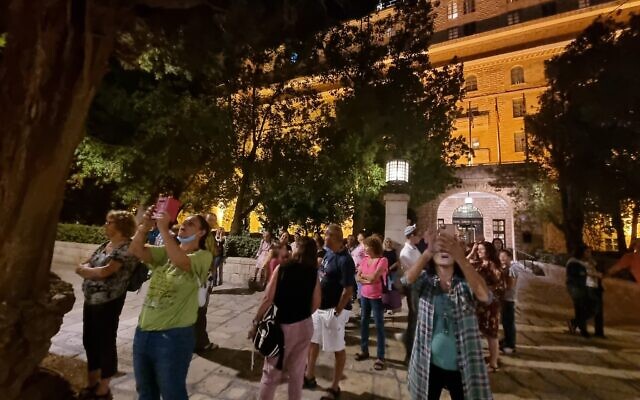
Guests alight momentarily from the night bus tour in front of the King David Hotel and across from the YMCA, for a photo op. (Shmuel Bar-Am)
Directly across the street, the splendid King David Hotel was constructed in 1931 out of an exquisite pink stone quarried in Hebron. The most elegant hotel in the country then — and, say some, until today — it had 200 rooms with an adjacent bath — some even with hot running water. In 1935 the British leased the hotel for use as the mandate’s administrative headquarters, and passengers will hear from the guide about an attack by the Jewish underground in 1946.
A few months ago, the Jerusalem municipality inaugurated its newest project: a unique fountain at the bottom of King David Street. The arched sculpture, with well-lit, watery strings, is titled David’s Harp and, like the biblical harp whose strings David was wont to pluck, has had a wonderfully calming effect on the traffic of this busy byway.
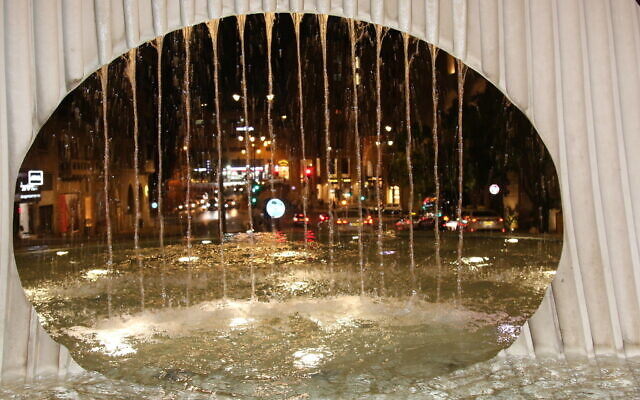
A view through the new David’s harp-inspired fountain on King David Street in Jerusalem. (Shmuel Bar-Am)
A restored fountain in nearby Paris Square is a welcome sight after years of neglect. The plaza has been around since 1959; the fountain was a gift from the city of Paris in 2007. Jerusalem Mayor Moshe Leon inaugurated the renovated fountain on March 28 this year. Along with artistic lighting, trees and benches, the plaza is graced with especially durable Italian granite tiles whose hue and shape blend perfectly with its original design.
One of the most well-known plazas in the city, Paris Square connects four major streets: King George, Agron, Ramban and Keren Hayesod (so-called after the Hebrew name for the United Jewish Appeal). It stands at the beginning of the Rehavia neighborhood, home of many of Jerusalem’s elite and wealthy from the 1920s, when it was founded, until today.
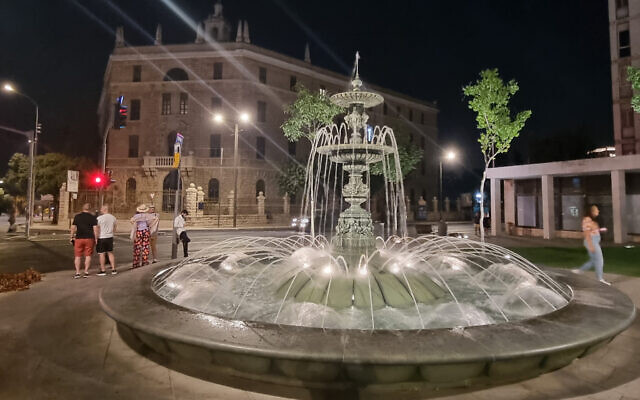
Jerusalem’s Paris Square at night. (Shmuel Bar-Am)
Among Rehavia’s famous residents over the years: the chairman of the Jewish National Fund for 30 years, Menachem Ussishkin, famous pianist Talma Yellin, and the only Jewish Supreme Court justice during the British Mandate, Gad Frumkin. Oh, and last but not least, Israel’s prime ministers, who have lived in the official premier’s residence located on Balfour Street beginning with Yitzhak Rabin in 1974.
The bus continues on a road above a monastery built in the 10th century by monks from Georgiaa country on the eastern end of the Black Sea. While there are no night lights shining on the monastery, it is located along a well-lit pedestrian and bicycle path — one of the dozens that have popped up recently in an ongoing project by the municipality. Then, after passing the beloved Sacher Park, the bus reaches a cultural center called Givat Ram, home to the Israel Museum.
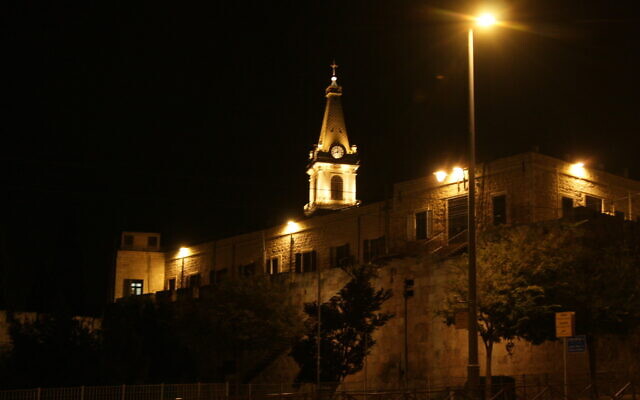
Monastery of St. Savior. (Shmuel Bar-Am)
Until 1965, Jerusalem’s art, archeology and Judaica collections were dispersed all over the city. Surprisingly, however, when these assorted items were finally combined into one large complex there wasn’t very much to see. But the Israel Museum founders did not despair — they were absolutely certain that someday in the not-too-distant future, their museum would become the world-famous institution that it is today.
Passengers on the bus get a wonderful view of the museum’s unusual exterior design: a series of buildings with temporary outer walls that allowed for future expansion. And, indeed, once open, the Israel Museum soon began to grow by leaps and bounds, and it wasn’t long before new buildings were added to the complex. Today everyone who comes to Jerusalem visits this amazing museum.
Under the white dome of the museum’s Shrine of the Book are the celebrated Dead Sea Scrolls, along with information about the unique Essene community that buried them, its day-to-day lifestyle and the art of copying scrolls. Most of these scrolls predate the last-known biblical text — the Aleppo Codex, also on display — by at least 1,000 years.
The dome is white and the body of the shrine is black, representing the second-temple scroll of the End of Days: The War of the Sons of Light against the Sons of Darkness. During visiting hours, it looks like the dome is being watered (like a garden) from above. This is not to keep the air-conditioned shrine cool, but to symbolize purity and rebirth.
Possessed of a unique concept, the Bible Lands Museum is located directly across from the Israel Museum, because contrary to what many people thought when it opened in 1992, the items on view were discovered not only in the Holy Land, but in countries whose ancient cultures preceded our own. The artifacts’ descriptions relate to the peoples who influenced Father Abraham, whose merchants traveled back and forth across the tiny strip that would become the land of Israel, and whose customs and traditions provide the backdrop to the Jewish religion, the Jewish spirit and the Jewish homeland.
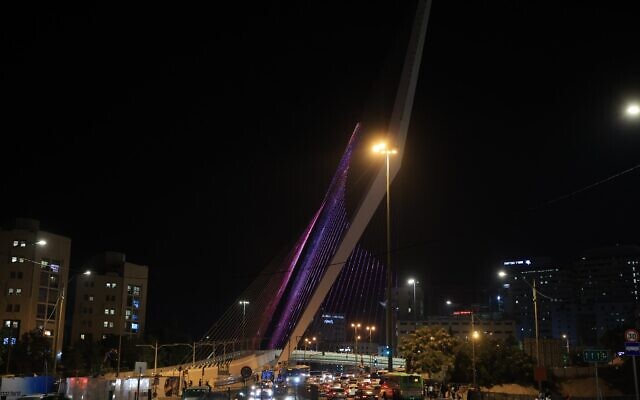
A view of Jerusalem’s Bridge of Strings at night. (Yulia Berzon/PAMI)
Inaugurated in 2008, the multi-colored Bridge of Strings was the subject of tremendous controversy for years because it was hugely expensive. Besides, it was so contemporary in style that it didn’t conform to residents’ image of an ancient, holy city. In time, as people passed over it on the glass-sided pedestrian bridge while traveling the light rail or when driving in and out of the city, those who opposed it simply got accustomed to its 188-meter (617-foot) mast and 66 cables.
The Light Tour continues past the hi-tech center Har Hotzvim, then moves into the Sanhedria neighborhood, site of burial caves nearly 2,000 years old. Also in Sanhedria: a cemetery that was opened during the War of Independence in 1948, after the traditional Jewish burial grounds on the Mount of Olives became inaccessible to Jews.
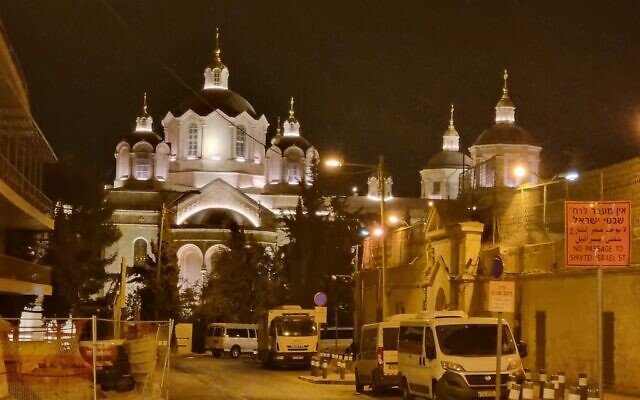
The majestic Trinity Cathedral in Jerusalem’s Russian Compound. (Shmuel Bar-Am)
Another of the bus’s three stops is at Jerusalem’s Russian Compound, built in 1860. Located behind today’s City Hall, the property had been eyed by both the Jews and the Russians — but the Turks, who ruled at the time, sold it to the Russians, who immediately began building a cathedral, a hospital and a series of hostels for the thousands of Russian pilgrims who swarmed to the Holy Land each year.
The lights on the restored Sergei Palace Hotel and the Cathedral of the Trinity, located on either side of the compound, are absolutely stunning. Inaugurated in 1872, the cathedral was graced by flashy green domes for years, but they were painted dark grey in 1996. Inevitably, during the Cold War, its continually changing priests were widely believed to be working for the KGB.
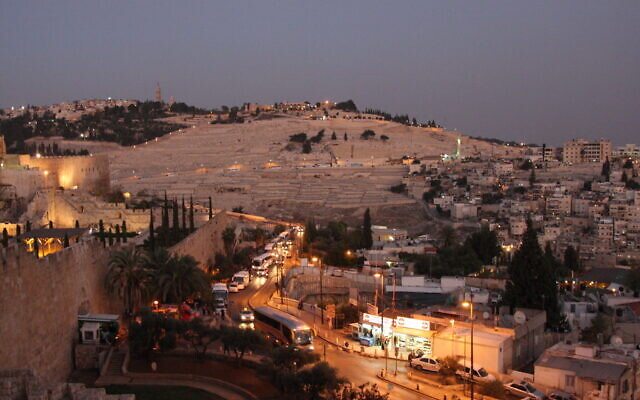
A view of the Mount of Olives and Jerusalem’s Silwan neighborhood at night. (Shmuel Bar-Am)
The third stop is outside the Old City Walls and next to the Mount of Olives. Lights shine on the prophet Zechariah’s ancient tomb and, of course, the Church of Mary Magdalene. Built by Alexander III of Russia, the Church of Mary Magdalene boasts gilded, onion-shaped domes. These brilliant domes jut out from a monumental Russian-style body that stands proudly against the night sky.
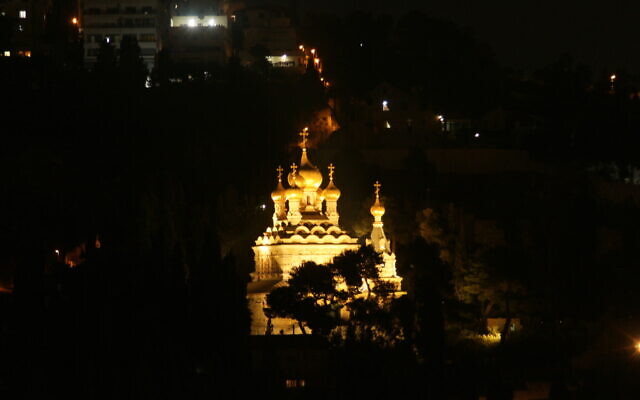
The Church of Mary Magdalene on the Mount of Olives in Jerusalem. (Shmuel Bar-Am)
The project runs through December. For information on the Light Tour or to order tickets, see the project’s website.
Aviva Bar-Am is the author of seven English-language guides to Israel.
Shmuel Bar-Am is a licensed tour guide who provides private, customized tours in Israel for individuals, families and small groups.